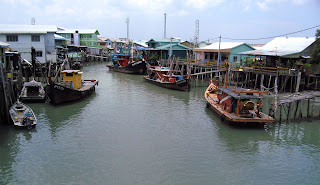This is an extract from my latest book, Wooden Wonders: Traditional Malaysian Fishing Boats
By design, boats place people far out on the water in an unnatural and hazardous environment. Therefore, boats are conservative in their design and often enshrouded by ritual and symbolic elements derived from belief systems. If one is to have faith in a boat when at sea, it seems natural to want to imbue the craft with as much safety as possible, both physical and spiritual. Horridge (1995) notes:
Because the use of them is dangerous, boats are particularly conservative structures and all cultures adhere to their own proven designs. Rigs are more easily copied than hull structures. When changes in design are introduced they are not admitted. In consequence, boatbuilding techniques may survive unchanged for 1000 years or may be quickly modified in a single generation as happens when designs are transferred from elsewhere.
Indigenous boat design knowledge can derive from traditional influences that lie outside the realm of naval architecture. This indigenous knowledge can consider available construction materials and fasteners as well as specific boat applications. This knowledge also leads to design details that affect performance and safety. When asked to explain specifics about a design, traditional builders may respond in a generic fashion, indicating there is no other way to design the boat or the design gives better performance. Construction details have been relayed from their ancestors and deviations from this tradition are considered dangerous (Horridge, 1995).
The details of the boat are ostensibly designed in response to a particular need. For example, the sharp bow allows a boat to pierce waves, a shallow draft allows passage over sandbars and an open transom allows nets to be easily pulled onboard. The overall boat design is dictated by needs for stability, buoyancy, maneuverability, seakindliness, draft restrictions, superstructure, and equipment requirements. However, in addition to these mechanistic elements, boat designs also derive from traditional designs, traditional construction methods, and available materials. In addition to these traditional influences, boat design is influenced by perceptions regarding durability, safety, comfort, and maintenance.
Boat designers make judgments as they
contend with many conflicting design issues such as performance versus aesthetics, stability versus capacity, comfort
versus seakeeping, safety versus speed, safety
versus ease of use, hull size versus operating cost, and fuel efficiency
versus production cost. The following
sections describe a few important mechanistic factors that may be
helpful in considering the photographs and data that follow.
[o1]Remain as non-italic & bold.

No comments:
Post a Comment